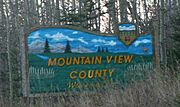Mountain View County facts for kids
Quick facts for kids
Mountain View County
|
||
|---|---|---|

Welcome sign
|
||
|
||

Location within Alberta
|
||
| Country | Canada | |
| Province | Alberta | |
| Region | Central Alberta | |
| Census division | 6 | |
| Established | March 15, 1944 as M.D. of Mountain View No. 280 | |
| Incorporated | January 1, 1961 as County of Mountain View No. 17 | |
| Name changed | January 21, 1998 to Mountain View County | |
| Area
(2021)
|
||
| • Land | 3,763.42 km2 (1,453.06 sq mi) | |
| Population
(2021)
|
||
| • Total | 12,981 | |
| • Density | 3.4/km2 (9/sq mi) | |
| Time zone | UTC−7 (MST) | |
| • Summer (DST) | UTC−6 (MDT) | |
Mountain View County is a special type of local government area in central Alberta, Canada. It's located between two big cities, Calgary and Red Deer. The main office for the county government is just north of the town of Didsbury. This county is part of a group called Rural Municipalities of Alberta, which helps local areas work together.
Contents
History of Mountain View County
Early Settlement and Railways
The first official maps of this area were made in 1883. This was around the time the Canadian Pacific Railway arrived in Calgary. Back then, Calgary was just a small settlement. Before highways, people and goods traveled between Calgary and Edmonton by wagon. They used a route called the Calgary and Edmonton Trail.
In 1890, the Calgary and Edmonton Railway began building its tracks. By the end of that year, the railway reached the area that is now Mountain View County. A few people had already settled here before 1890. However, most people started moving in after the railway arrived.
On July 27, 1891, the first train traveled all the way from Calgary to Strathcona. This started regular train service for the next 60 years. The Canadian Pacific Railway now runs this line. It is still their main connection between Calgary and Edmonton.
Growth of Communities
After 1891, many homesteaders came to the region. They arrived from Europe and North America. New settlements grew around the railway stops. These included Carstairs, Didsbury, and Olds.
Early settlers often formed close-knit communities. For example, many Mennonite families settled near Didsbury. They came from Europe through Ontario around 1900. A large number of German settlers from the American Midwest also moved near Olds. Norwegian pioneers traveled west towards Sundre and Bergen.
Forming Local Government
As more people arrived, they needed local services. This led to the creation of "Improvement Districts." These were small local government units. They were usually about 72 square miles (186 km²) in size. Their jobs included setting local taxes. They also kept track of necessary local improvements.
In December 1911, Alberta's government passed new laws. These laws aimed to give rural areas more self-government. The Municipal Act of 1912 encouraged these small districts to join together. They could form larger rural municipalities.
At first, people were not very keen on joining up. Most rural residents in Mountain View voted against it in 1912. Only the Rural Municipality of Mountain View No. 310 was created. It combined four improvement districts around Olds and Didsbury. This happened on December 9, 1912. It was one of 55 rural municipalities formed across the province. Mountain View was one of the first to join, and others soon followed.
Becoming Mountain View County
The Municipal District of Mountain View No. 49 became the County of Mountain View No. 17. This change happened on January 1, 1961. William J. Bagnall was chosen as the county's first Reeve. A Reeve is like a mayor for a county. Bagnall served as Reeve until 1980.
The new county chose Didsbury for its main office. In October 1962, a new building opened. It housed both the county government and the school board. This building was used until 2005. That's when a new, modern office was built. It's located near the Olds-Didsbury Airport along Highway 2A.
On January 21, 1998, the County of Mountain View No. 17 changed its name. It became Mountain View County, which is what it's called today.
Geography of Mountain View County
Towns and Villages
Mountain View County surrounds several towns and villages. These are independent communities but are located within the county's boundaries.
|
Rural Neighbourhoods
In 2008, Mountain View County created 20 "rural neighbourhoods." These are specific areas within the county.
|
|
|
Population and Demographics
In 2021, Mountain View County had a population of 12,981 people. These people lived in 5,014 homes. This was a small decrease from its 2016 population of 13,074. The county covers a land area of about 3,763 square kilometers (1,453 square miles). This means there are about 3.4 people living in each square kilometer.
Economy
The main ways people make a living in Mountain View County are:
- Oil and gas (finding and producing oil and natural gas)
- Agriculture (farming and ranching)
- Forestry (working with forests and wood products)
- Tourism (people visiting the area for fun)
Education
Early Schools
In the early 1890s, the first schools started in the Mountain View County area. By 1930, there were almost 90 school districts. Many of these were "one-room school houses." These were common in rural areas. In 1936, the government allowed larger school divisions to form.
Modern School System
As local governments joined together, so did school boards. In 1955, the Mountain View Municipal District and Olds School Division No. 39 shared the same boundaries. When the County system began in 1961, the county government and school boards worked together. This continued until 1994.
Today, the Olds School Division No. 39 has become the Chinook's Edge School Division. This division still provides education for students in Mountain View County.


